Did you know this?
More Fascinating Facts for Did You Know This?
Could Pearl Harbor happen again?
 December 7, 1941 — Today marks the anniversary of the 1941 attack on Pearl Harbor — a surprise military strike by the Imperial Japanese Navy against the United States naval base in what was then the Territory of Hawaii that led to the United States’ entry into World War II.
December 7, 1941 — Today marks the anniversary of the 1941 attack on Pearl Harbor — a surprise military strike by the Imperial Japanese Navy against the United States naval base in what was then the Territory of Hawaii that led to the United States’ entry into World War II.
Here’s what happened:
- The attack commenced at 7:48 a.m. Hawaiian Time.
- The base was attacked by 353 Imperial Japanese fighter planes, bombers, and torpedo planes in two waves, launched from six aircraft carriers.
- All eight US Navy battleships were damaged, with four sunk. All but the USS Arizona (BB-39) were later raised, and six were returned to service and went on to fight in the war.
- The Japanese also sank or damaged three cruisers, three destroyers, an anti-aircraft training ship, and one mine-layer: 188 US aircraft were destroyed, 2,403 Americans were killed, and 1,178 others were wounded.
- Important base installations such as the power station, shipyard, maintenance, and fuel and torpedo storage facilities, as well as the submarine piers and headquarters building (also home of the intelligence section), were not attacked. Japanese losses were light: 29 aircraft and five midget submarines lost, and 64 servicemen killed. One Japanese sailor, Kazuo Sakamaki, was captured.
The following day, Dec. 8, the United States declared war on Japan. Domestic support for non-interventionism, which had been fading since the fall of France in 1940, disappeared. Clandestine support of the United Kingdom (e.g., the Neutrality Patrol) was replaced by active alliance. Subsequent operations by the United States prompted Nazi Germany and Fascist Italy to declare war on the United States on Dec. 11; the United States reciprocated the same day.
There were numerous historical precedents for unannounced military action by Japan. However, the lack of any formal warning, particularly while negotiations were still apparently ongoing, led President Franklin D. Roosevelt to proclaim Dec. 7, 1941, “a date which will live in infamy.” Because the attack happened without a declaration of war and without explicit warning, the attack on Pearl Harbor was judged by the Tokyo Trials to be a war crime.
Pearl Harbor Day: On Aug. 23, 1994, the US Congress, by Pub.L. 103–308, designated Dec. 7 of each year as National Pearl Harbor Remembrance Day. Today it is observed annually to remember and honor the 2,403 Americans who were killed in the surprise attack.
Could Pearl Harbor happen again? Check out this article by IntellectualTakeout.com writer Annie Holmqvist for her perspective.
What sparked the Great New Orleans Fire?
 March 21, 1788 — The Great New Orleans Fire today blew through 856 of the 1,100 structures in New Orleans, Louisiana (aka: New Spain). The blaze spanned the south central Vieux Carré from Burgundy to Chartres Street, and nearly touched the Mississippi River front buildings.
March 21, 1788 — The Great New Orleans Fire today blew through 856 of the 1,100 structures in New Orleans, Louisiana (aka: New Spain). The blaze spanned the south central Vieux Carré from Burgundy to Chartres Street, and nearly touched the Mississippi River front buildings.
The Good Friday blaze began about 1:30 p.m. at the home of Army Treasurer Don Vincente Jose Nuñez, at 619 Chartres Street, corner of Toulouse — less than a block from Jackson Square. But because the fire started on a holy day, priests refused to allow church bells to be rung as a fire alarm. Within five hours, it had consumed almost the entire city as it was fed by a strong wind from the southeast.
The fire destroyed virtually all major buildings in the then-city (which is now known as the French Quarter), including the church, municipal building, army barracks, armory, and jail. Colonial Governor Esteban Rodríguez Miró set up tents for the homeless.
Within six years, Colonial officials had replaced the wooden buildings with masonry structures that had courtyards, thick brick walls, arcades, and wrought iron balconies.
However, on December 8, 1794, another 212 buildings were destroyed in the “Great New Orleans Fire of 1794.” Rebuilding continued in Spanish style, and much of the French-style architecture that once was prominent disappeared from the city.
Who founded a settlement today that will become Chicago?
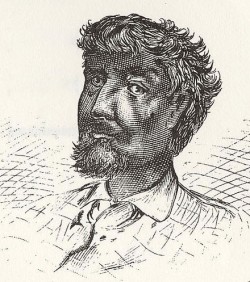 March 12, 1773 — Jean Baptiste Point du Sable is considered the first man to make his home in a US settlement, which today is Chicago. As a free black man born in Haiti before 1750, he was also the city’s first black resident.
March 12, 1773 — Jean Baptiste Point du Sable is considered the first man to make his home in a US settlement, which today is Chicago. As a free black man born in Haiti before 1750, he was also the city’s first black resident.
Starting in 1768, he operated as a fur trader with an official license from the British government and managed a trading post in Indiana. The area was Indian-owned (he was a tenant) and as a result Point du Sable was harassed by both British and American troops who passed through the Midwest.
Today, though, he left that behind and moved onto a piece of land where he established a farm with his wife, Catherine, and their two children. The family provided stability to an area that was frequented by peripatetic traders.
By the end of the Revolutionary War, Point du Sable’s farm prospered; people as far away as Philadelphia knew his to be the only farmed produce in the area.
Point du Sable left Chicago in 1800, selling his property to a neighbor. His wife did not sign the bill of sale, and is believed to have been deceased at the time.
He moved to St. Charles in Spanish Louisiana, but business deals did not go well, and was declared insolvent in the territory in 1813.By 1818, the once prosperous farmer was destitute and depended on the goodwill of a neighbor, possibly a lover, for his housekeeping. He died on August 28.
What is the history of the leap year?
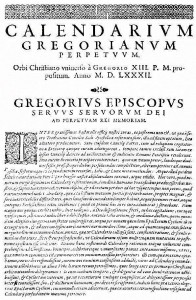 February 29, 1800 — Known as the leap day of the Gregorian calendar, February 29 is a date that occurs in most years that are divisible by 4 — such as 2008, 2012, 2016, 2020 and 2024. Introduced as part of the Julian reform, leap years began occurring on the 60th day of the Gregorian calendar; it repeats itself every 400 years, totaling exactly 20,871 weeks with 97 leap days.
February 29, 1800 — Known as the leap day of the Gregorian calendar, February 29 is a date that occurs in most years that are divisible by 4 — such as 2008, 2012, 2016, 2020 and 2024. Introduced as part of the Julian reform, leap years began occurring on the 60th day of the Gregorian calendar; it repeats itself every 400 years, totaling exactly 20,871 weeks with 97 leap days.
Over this period, February 29 falls on Sunday, Tuesday, and Thursday 13 times each; 14 times each on Friday and Saturday; and 15 times each on Monday and Wednesday. The order of the leap days is: Thursday, Tuesday, Sunday, Friday, Wednesday, Monday and Saturday.
Did you know: Adding a leap day (after 23 February) shifts the commemorations in the 1962 Roman Missal. The day following the Terminalia (February 23) was doubled, forming the “bis sextum”—literally ‘double sixth’, since February 24 was ‘the sixth day before the Kalends of March’ using Roman inclusive counting (March 1 was the ‘first day’).
Exceptions exist. The first day of the bis sextum (February 24) was usually regarded as the intercalated or “bissextile” day since the third century.[2] February 29 came to be regarded as the leap day when the Roman system of numbering days was replaced by sequential numbering in the late Middle Ages.
What is the theory behind the “Communist Manifesto,” which was published today in 1848?
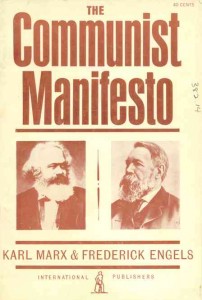 February 26, 1848 — Today, Karl Marx and Friedrich Engels published their “Communist Manifesto” — a political pamphlet recognised as one of the world’s most influential political manuscripts.
February 26, 1848 — Today, Karl Marx and Friedrich Engels published their “Communist Manifesto” — a political pamphlet recognised as one of the world’s most influential political manuscripts.
The German philosophers took an analytical approach to the class struggle (historical and then-present) by summarizing the problems of capitalism and the capitalist mode of production. Their theories about the nature of society and politics also features their ideas for how the capitalist society of the time would eventually be replaced by socialism, and then communism.
At first, it had little or no impact on the widespread and varied revolutionary movements of the mid-19th century Europe, or the US. But in time, their Communist Manifesto became one of the most widely read and discussed documents of the 20th century.
Following are the 10 planks of the theory:
1. Abolition of private property and the application of all rent to public purpose.
2. A heavy progressive or graduated income tax.
3. Abolition of all rights of inheritance.
4. Confiscation of the property of all emigrants and rebels.
5. Centralization of credit in the hands of the State, by means of a national bank with state capital and an exclusive monopoly.
6. Centralization of the means of communication and transportation in the hands of the State.
7. Extention of factories and instruments of production owned by the State, the bringing into cultivation of waste lands, and the improvement of the soil generally in accordance with a common plan.
8. Equal liablity of all to labor. Establishment of Industrial armies, especially for agriculture.
9. Combination of agriculture with manufacturing industries; gradual abolition of the distinction between town and country by a more equable distribution of the population over the country.
10. Free education for all children in government schools. Abolition of children’s factory labor in its present form. Combination of education with industrial production.
Which was the first American ship to sail from the US to China in 1784?
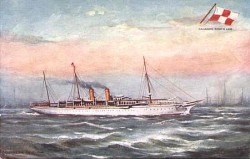 February 22, 1784 — The first US ship to conduct trade with China, “Empress of China,” sailed from New York today.
February 22, 1784 — The first US ship to conduct trade with China, “Empress of China,” sailed from New York today.
Also known as Chinese Queen, this three-masted, square-rigged sailing ship of 360 tons was initially built in 1783 for service as a privateer.
After the Treaty of Paris brought a formal end to the American Revolutionary War, the vessel was refitted for commercial purposes. She became the first American ship to sail from the newly independent United States to China, opening what is known today as the Old China Trade and transporting the first official representative of the American government to Canton.
The first American merchant vessel to enter Chinese waters left New York harbor on Washington’s birthday, February 22, 1784. The Empress returned to New York on May 11, 1785 after a round voyage of 14 months and 24 days. The success of the voyage encouraged others to invest in further trading with China.
The ship’s captain John Green (1736–1796) was a former U.S. naval officer, its two business agents (supercargos), Samuel Shaw (1754–1794) and Thomas Randall (1723–1797), were former officers in the U.S. Continental Army, and its syndicate of owners, including Robert Morris (1734–1806) were some of the richest men in the new nation.
Who was the first female telegraph operator?
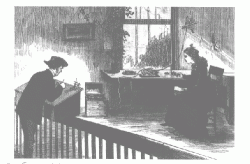 February 21, 1846 — Sarah Bagley (April 19, 1805 – June 23, 1883) today became America’s first woman telegraph operator.
February 21, 1846 — Sarah Bagley (April 19, 1805 – June 23, 1883) today became America’s first woman telegraph operator.
An advocate for women’s rights, and one of the most important labor leaders in New England during the 1840s, she campaigned to make 10 hours of labor per day the maximum in Massachusetts.
Her activities in support of the mill workers in Lowell, Massachusetts put her in contact with a broader network of reformers in areas of women’s rights, communitarianism, abolition, peace, prison reform, and health reform.
Bagley and her coworkers became familiar with middle-class reform activities, demonstrating the ways in which working people embraced this reform impulse as they transformed and critiqued some of its key elements.
Sarah’s activities within the labor movement reveal many of the tensions that underlay relations between male and female working people as well as the constraints of gender that female activists had to overcome.
Who was Jonathan Cilley?
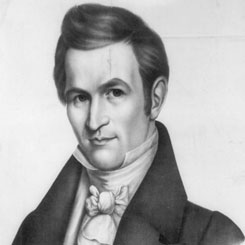 February 24, 1838 — Today, Jonathan Cilley of Maine (pictured right) was killed by Representative William Graves of Kentucky in a duel on the outskirts of D.C., in Prince George’s County, Maryland.
February 24, 1838 — Today, Jonathan Cilley of Maine (pictured right) was killed by Representative William Graves of Kentucky in a duel on the outskirts of D.C., in Prince George’s County, Maryland.
Here’s the back story: Graves approached Cilley with a letter at the behest of a newspaper editor, James Webb, who was incensed about a bribery accusation Cilley had made on the House Floor. Cilley refused to accept the letter; which Graves interpreted the refusal as a direct insult to his character. So he challenged Cilley to a duel.
Of course, neither man had any known grievance with the other prior to the incident. With two other Members of the House present, Henry Wise of Virginia and Delegate George Jones of Wisconsin (the dueling seconds for both men), the duel went beyond the customary two rounds, resulting in Cilley’s death in the third round.
After the ensuing House investigation, Graves, along with Wise and Jones, were recommended for censure after Cilley’s death. Although the House refused to impose the censure recommendation it offered a bill to “prohibit the giving or accepting within the District of Columbia, of a challenge to fight a duel, and for the punishment thereof.”
On February 27, 1838 — The House Chamber hosted a funeral, attended by the President Martin Van Buren and other statesmen, to honor Cilley.
Celebrate President’s Day with a history lesson: What is the story behind dueling in America?
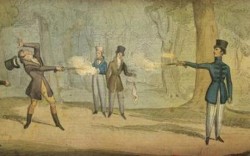 February 20, 1839 — Today, Congress passed legislation barring the practice of dueling in the District of Columbia.
February 20, 1839 — Today, Congress passed legislation barring the practice of dueling in the District of Columbia.
Passage of the law was inspired by a 1838 duel in which Kentucky Rep. William Graves killed Maine Rep. Jonathan Cilley at the Bladensburg Duelling Grounds near the DC-Maryland border. The House, choosing not to censure Graves or the two other congressman present at the duel, instead presented a bill to “prohibit the giving or accepting within the District of Columbia, of a challenge to fight a duel, and for the punishment thereof.”
The law did little to deter dueling, which was an ancient practice that was originally a legal means to settle disputes in barbarian Germanic tribes. Duels of honor, fought primarily between noblemen, were an extralegal means to defend one’s honor against personal insults. These duels were governed by codes, the most famous of which is the Code Duello, a list of 26 rules drafted in 1777 by Irish duelers.
An American version of the code was drafted in 1838 by South Carolina Gov. John Lyde Wilson. A duel was negotiated through companions of the two duelers, known as “seconds.” The offended party would issue a challenge; the challenger could either apologize or accept a duel using the weapon of his choice (usually pistols, but swords were also allowed).
In America, duels were most prevalent in the South, particularly among upper-class gentlemen. Men who were challenged to a duel were expected to accept; those who refused faced public embarrassment. One South Carolina general, recalling a duel in his youth, remarked, “Well I never did clearly understand what it was about, but you know it was a time when all gentlemen fought.”
What were the Apache Wars, and how long did they last?
 February 4, 1861 — Apache Chief Cochise was arrested in Arizona today by the U.S. Army for raiding a ranch. He then escaped and declared war, beginning the period known as the Apache Wars, which lasted 25 years.
February 4, 1861 — Apache Chief Cochise was arrested in Arizona today by the U.S. Army for raiding a ranch. He then escaped and declared war, beginning the period known as the Apache Wars, which lasted 25 years.
Its origins started a year before the first conflict when a fraction of Mexico became part of the United States in the aftermath of the Mexican-American War. Native Mexicans became Native Americans for the series of conflicts where a significant part of the Westward Expansion Trails in the American frontier.
The first conflicts between the Apache date to the earliest Spanish settlements, but the specific set of conflicts now known as the Apache Wars began during the Mexican-American War. The first United States Army campaigns specifically against the Apache began in 1849, and the last major battle ended with the surrender of Geronimo in 1886.
Geronimo is probably the most notable Apache warrior of that time period, but he was not alone. He belonged to a Chiricahua Apache band. After two decades of guerrilla warfare, Cochise, one of the leaders of the Chiricahua band, chose to make peace with the US. He agreed to relocate his people to a reservation in the Chiricahua Mountains. Soon afterward in 1874, Cochise died. In a change of policy, the U.S. government decided to move the Chiricahua to the San Carlos reservation in 1876.[citation needed] Half complied and the other half, led by Geronimo, escaped to Mexico.
In the spring of 1877, the U.S. captured Geronimo and brought him to the San Carlos reservation. He stayed there until September 1881. As soldiers gathered near the reservation, he feared being imprisoned for previous activities. He fled the reservation with 700 Apache and went to Mexico again.
Who manufactured the first adding machine?
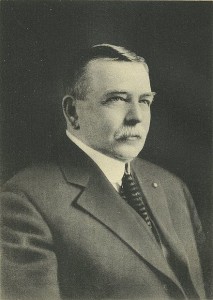 February 5, 1887 — Dorr Eugene Felt (1862–1930) of Beloit, Wisconsin began manufacturing his comptometer today, taking the adding machine to new heights.
February 5, 1887 — Dorr Eugene Felt (1862–1930) of Beloit, Wisconsin began manufacturing his comptometer today, taking the adding machine to new heights.
It was an invention 220 years in the making, for the original creators of adding machines were Blaise Pascal and Wilhelm Schickard, who in 1642 built the first mechanical calculator. Pascal came up with an adding machine that could perform additions and subtractions directly and multiplication and divisions by repetitions. Schickard’s machine, invented several decades earlier, was supported by a mechanised form of multiplication tables.
These two were followed by a string of inventors and inventions leading to those of Thomas de Colmar who launched the mechanical calculator industry in 1851 when he released his simplified arithmometer. It took him thirty years to refine his machine, patented in 1820, into a simpler and more reliable form.
However, the machine didn’t gain widespread use until Felt and Chicago businessman Robert Tarrant partnered two years later. On Jan. 25, 1889, they incorporated the Felt & Tarrant Manufacturing Company, and sales took off.
Felt later went on to invent more devices and acquired 46 domestic patents and 25 foreign ones. The original macaroni box prototype and the first Comptograph ever sold are now part of the Smithsonian Museum collection of antique calculators. Felt was awarded the John Scott Medal of The Franklin Institute in 1889. He also was the first ambassador for the Department of Commerce formed to study labor abroad after World War I.
Who was Arthur St. Clair?
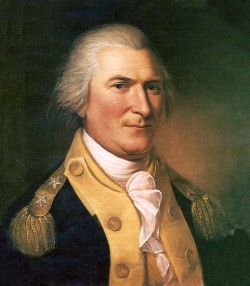 February 2, 1787 — Arthur St. Clair was elected the 9th president of the Continental Congress today. One of his first jobs was to deal with Shay’s Rebellion, because American farmers were up in arms against state and local enforcement of tax collections and judgments for debt.
February 2, 1787 — Arthur St. Clair was elected the 9th president of the Continental Congress today. One of his first jobs was to deal with Shay’s Rebellion, because American farmers were up in arms against state and local enforcement of tax collections and judgments for debt.
Born in Scotland, St. Clair served in the British Army during the French and Indian War before settling in Pennsylvania, where he held local office. During the American Revolutionary War, he rose to the rank of major general in the Continental Army, but lost his command after a controversial retreat from Fort Ticonderoga.
After the war, he served as president of the Continental Congress. During his term, the Northwest Ordinance passed, which provided a method for admitting new states to the Union from the Northwest Territory.
St. Clair was then made governor of the Northwest Territory in 1788, and then the portion that would become Ohio in 1800. In 1791, St. Clair commanded the American forces in what was the worst ever US defeat against the American Indians. Politically out-of-step with the Jefferson administration, he was replaced as governor in 1802.
St. Clair died in poverty in Greensburg, PA, on August 31, 1818. At the time, he lived with his daughter, Louisa St. Clair Robb and her family on the ridge between Ligonier and Greensburg. He was buried under a Masonic monument in St. Clair Park in downtown Greensburg. His wife of 58 years, Phoebe Bayard, died shortly after and is buried beside him.
What is National Freedom Day?
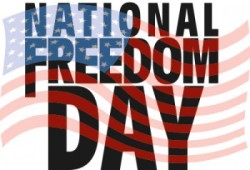
February 1, 1865 — Today is National Freedom Day, which celebrates the signing of a resolution that proposed the 13th Amendment of the Constitution, which outlaws slavery.
It declares: “Neither slavery nor involuntary servitude, except as a punishment for crime whereof the party shall have been duly convicted, shall exist within the United States, or any place subject to their jurisdiction.”
Congress passed it on Jan. 31, 1865, it was ratified by the following December.
Maj. Richard Robert Wright, Sr., a former slave who founded the National Freedom Day Association, played a crucial role in creating the observance. A community leader in Philadelphia, Wright hoped to see a day that would be dedicated to celebrating freedom for all Americans.
What was Shays’ Rebellion?
 January 25, 1787 — Shays’ Rebellion suffered a setback today when debt-ridden farmers, led by Capt Daniel Shays, failed to capture an arsenal at Springfield, Mass.
January 25, 1787 — Shays’ Rebellion suffered a setback today when debt-ridden farmers, led by Capt Daniel Shays, failed to capture an arsenal at Springfield, Mass.
Did you know: Shays ’ Rebellion was an armed uprising in Massachusetts (mostly in and around Springfield) during 1786 and 1787. Revolutionary War veteran Daniel Shays led four thousand rebels (called Shaysites) in rising up against perceived economic injustices and suspension of civil rights by Massachusetts, and in a later attempt to capture the United States’ national weapons arsenal at the U.S. Armory at Springfield.
Although Shays’ Rebellion met with defeat militarily against a privately-raised militia, it prompted numerous national leaders (including George Washington, who came out of retirement to deal with issues raised by Shays’ Rebellion) to call for a stronger national government to suppress future rebellions, resulting in the U.S. Constitutional Convention and according to historian Leonard L. Richards, “fundamentally altering the course of U.S. history.”
The events of the rebellion are believed to have affected the debates on the shape of the new government. In fact, the shock of Shays’ Rebellion is said to have drawn retired General George Washington back into public life, leading to his terms as the United States’ first President. The exact nature and consequence of the rebellion’s influence on the content of the Constitution and the ratification debates continues to be a subject of historical discussion and debate.
How many earthquakes struck New Madrid, Missouri?
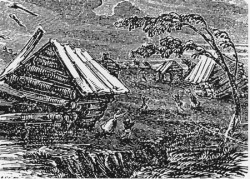 January 23, 1812 — Three earthquakes struck New Madrid, Missouri between 1811-1812, including one that hit today. They remain the most powerful earthquakes to hit the contiguous United States east of the Rocky Mountains in recorded history.
January 23, 1812 — Three earthquakes struck New Madrid, Missouri between 1811-1812, including one that hit today. They remain the most powerful earthquakes to hit the contiguous United States east of the Rocky Mountains in recorded history.
They were felt strongly over roughly 130,000 square kilometers (50,000 sq mi), and moderately across nearly 3 million square kilometers (1 million square miles).
The trio of earthquakes included:
• December 16, 1811 — The epicenter in northeast Arkansas caused only slight damage to manmade structures, mainly because of the sparse population in the epicentral area.
• Today: January 23, 1812 — The epicenter was in the Missouri Bootheel. The meizoseismal area was characterized by general ground warping, ejections, fissuring, severe landslides, and caving of stream banks. Johnson and Schweig attributed this earthquake to a rupture on the New Madrid North Fault. This may have placed strain on the Reelfoot Fault.
• February 7, 1812 — The epicenter near New Madrid was destroyed. In St. Louis, many houses were severely damaged, and their chimneys were toppled. This shock was definitively attributed to the Reelfoot Fault by Johnston and Schweig. Uplift along a segment of this reverse fault created temporary waterfalls on the Mississippi at Kentucky Bend, created waves that propagated upstream, and caused the formation of Reelfoot Lake by obstructing streams in what is now Lake County, Tennessee.
Why did haberdasher John Hetherington’s top hat cause so much controversy in 1797?
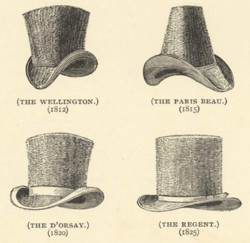 January 15, 1797 — English haberdasher John Hetherington supposedly caused a riot when he first wore a top hat in public today.
January 15, 1797 — English haberdasher John Hetherington supposedly caused a riot when he first wore a top hat in public today.
Reportedly, “he appeared on the public highway wearing upon his head what he called a silk hat (which was shiny lustre and calculated to frighten timid people)” and the officers of the Crown stated that “several women fainted at the unusual sight, while children screamed, dogs yelped and a younger son of Cordwainer Thomas was thrown down by the crowd which collected and had his right arm broken.”
He was arraigned before the Lord Mayor on a charge of breach of the peace and inciting a riot, and was required to post a £500 bond.
What was the Flag Act of 1794?
 January 13, 1794 — The Flag Act of 1794 was signed into law by President George Washington today, providing for 15 stripes as well as 15 stars.
January 13, 1794 — The Flag Act of 1794 was signed into law by President George Washington today, providing for 15 stripes as well as 15 stars.
The change in the flag was issued to accommodate the admission into the Union of the states of Vermont and Kentucky. This would be the only official flag of the United States not to have thirteen stripes.
It was the second of three laws that sought to define the design of the US flag. (See those below.) And click here for the official law of the Flag Act of 1794.
The first was the Flag Act of 1777, passed by the Second Continental Congress on June 14, 1777, in response to a petition made by an American Indian nation on June 3 for “an American Flag.” As a result, June 14 is now celebrated as Flag Day in the United States. “Resolved, That the flag of the thirteen United States be thirteen stripes, alternate red and white; that the union be thirteen stars, white in a blue field, representing a new constellation.”
The third was the Flag Act of 1818, which was enacted by Congress on April 4, 1818. It provided for the modern rule of having thirteen stripes to represent the original thirteen colonies and having the number of stars match the number of states. It also provided that subsequent changes in the number of stars be made on July 4, Independence Day. “An Act to establish the flag of the United States. Be it enacted by the Senate and House of Representatives of the United States of America, in Congress Assembled, That from and after the fourth day of July next, the flag of the United States be thirteen horizontal stripes, alternate red and white: that the union be twenty stars, white in a blue field. And be it further enacted, That on the admission of every new state into the Union, one star be added to the union of the flag; and that such addition shall take effect of the fourth day of July then next succeeding such admission.”
Who was the first Jewish person elected to office in America?
 January 11, 1775 — Francis Salvador (1747-1776) became the first Jew elected to public office in the colonies when today to be part of the Provincial Congress (one of several extra-legal legislative bodies established in some of the Thirteen Colonies early in the Revolution).
January 11, 1775 — Francis Salvador (1747-1776) became the first Jew elected to public office in the colonies when today to be part of the Provincial Congress (one of several extra-legal legislative bodies established in some of the Thirteen Colonies early in the Revolution).
A young English plantation owner in South Carolina, Salvador came from the Sephardic Jewish community of London. His uncle, Joseph Salvador, was a prominent businessman, and the only Jewish director of the British East India Company.
Unfortunately, Salvador was also the first Jew killed in the American Revolutionary War, fighting with the militia on the South Carolina frontier against Loyalists and their Cherokeeallies.
On July 1, 1776, the Indians began attacking frontier families in Ninety Six District. Salvador rode from his lands to the White Hall plantation of Major Andrew Williamson, 28 miles (45 km) away, to raise the alarm. Salvador took part in the engagements that followed. On July 31, Major Williamson captured two white Loyalists. They led his 330-men militia into an ambush by their fellow Tories and Cherokee allies at the Keowee River.
Salvador was shot and fell into the bushes, but was discovered and scalped by the Cherokee that night. He died from his wounds at age 29.
Who was Robert Owen and what were his views on socialism?
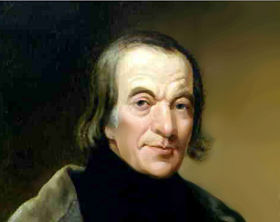 January 3, 1825 — Scottish factory owner Robert Owen (May 14, 1771 – November 17, 1858) bought 30,000 acres in Indiana today as a site for his New Harmony utopian community. The Welsh socialist and social reformer invested the bulk of his fortune in the experimental 1,000-member colony on the banks of Indiana’s Wabash River.
January 3, 1825 — Scottish factory owner Robert Owen (May 14, 1771 – November 17, 1858) bought 30,000 acres in Indiana today as a site for his New Harmony utopian community. The Welsh socialist and social reformer invested the bulk of his fortune in the experimental 1,000-member colony on the banks of Indiana’s Wabash River.
Owen advocated the elimination of poverty through the establishment of self-sustaining communities, and experimented with such a community until 1828. He introduced innovative industrial reforms at his New Lanark Mills during the early 1800s, making it a place of pilgrimage for reformers and statesmen from all over Europe.
According to newworldencyclopedia.org: “Owen believed that a man’s character was completely formed by his environment and circumstances, and that placing man under the proper physical, moral, and social influences from his earliest years was the key to the formation of good character and to the amelioration of social problems. Owen’s doctrines were adopted as an expression of the workers’ aspirations, and he became a leader of the trade union movement in England, which advocated control of production by the workers.”
The word “socialism” first became current in the discussions of the “Association of all Classes of all Nations,” which Owen formed 10 years later, in 1835.
What is the Treaty of New Echota?
 December 29, 1835 — The Treaty of New Echota is signed today, ceding all the lands of the Cherokee east of the Mississippi River to the US.
December 29, 1835 — The Treaty of New Echota is signed today, ceding all the lands of the Cherokee east of the Mississippi River to the US.
Although the treaty was not approved by the Cherokee National Council nor signed by Principal Chief John Ross, it was amended and ratified by the U.S. Senate in March 1836.
It became the legal basis for the forcible removal known as the Trail of Tears — the forced relocation 1836-1839 of the Cherokee Nation from their lands in Georgia, South Carolina, North Carolina, Tennessee, Texas, and Alabama to the Indian Territory (present day Oklahoma).
As a result, an estimated 4,000 Cherokee died.
What was the world’s first public railway to use a steam locomotive?
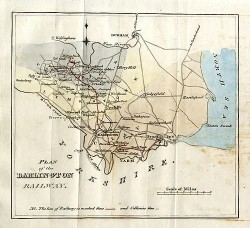 December 27, 1825 — The world’s first public railway using a steam locomotive was completed in England today by the Stockton and Darlington Railway (S&DR).
December 27, 1825 — The world’s first public railway using a steam locomotive was completed in England today by the Stockton and Darlington Railway (S&DR).
Operated in north-east England from 1825-1863, it was the first line to connect collieries (a coal mine and the buildings and equipment associated with it) near Shildon with Stockton-on-Tees and Darlington. The line was soon extended to a new port and town at Middlesbrough.
While coal waggons were hauled by steam locomotives from the start, passengers were carried in coaches drawn by horses until carriages hauled by steam locomotives were introduced in 1833.
How many copies of “A Christmas Carol” are bought when it is published today in 1843?
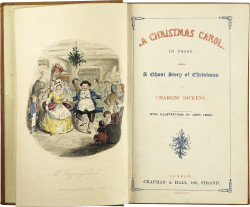 December 19, 1843 — “A Christmas Carol” by Charles Dickens is published today, selling 6,000 copies the first day.
December 19, 1843 — “A Christmas Carol” by Charles Dickens is published today, selling 6,000 copies the first day.
The idea to write the book is said to have come to him in October of 1843. “His wife was due to have a baby in January, and he thought he’d pay for her medical care and a trip abroad by writing a short book that could be sold at Christmas,” according to charlesdickenschristmascarol.com.
In a six-week rush, and published at his own expense, the book became one of many public and private efforts by Dickens to bring about social reform.
“His disgust with the blinkered conceit of the privileged classes was genuine and lifelong,” according to todayinliterature. “In this letter he rails at the ‘sleek, slobbering, bow-paunched, over-fed, apoplectic, snorting cattle’ with whom he was forced to eat a charity dinner; in that, he predicts dire consequences for their ‘stupendous ignorance of what is passing out of doors.'”
Some in the upper classes were like-minded; some went as far as they dared to mock Dickens and the “cult of benevolence” with which they associated him. They dubbed him “Mr. Popular Sentiment,” and scoffed at the naive politics of his novels, calling them the “gospel of geniality.’
After A Christmas Carol sold out the first day, Dickens is said to have had high hopes that his blow for the poor might also do something for his own poverty. By May of 1844, it was in its seventh edition. Unfortunately, high production costs ate up most of his expected profit, and then legal fees to contest a pirated edition of the book left him in debt.
Where was the Aztec calendar rediscovered today in 1790?
 December 17, 1790 — The Aztec calendar stone — known as the Sun Stone, or Stone of the Five Eras — was rediscovered today during repairs on the Mexico City Cathedral.
December 17, 1790 — The Aztec calendar stone — known as the Sun Stone, or Stone of the Five Eras — was rediscovered today during repairs on the Mexico City Cathedral.
The Aztecs had determined the Earth’s orbit lasted 365.2420 days. This number is slightly closer to the true value (365.2422) than the 365.2425 figured by the Gregorian version in 1582.
Shortly after the Spanish Conquest, the monolithic sculpture was buried in the Zócalo, which was the main square of Mexico City. The late post-classic Mexica sculpture is perhaps the most famous work of Aztec sculpture. Measuring 11.75 feet in diameter and 3.22 feet thick, it weighs about 24 tons.
Believed at first to be a native take on the typical calendar, anthropologists have revised original theories to give the Sun Stone a special ritual significance.
According to mapsofworld: The Aztecs, unlike their European counterparts using the Julian calendar or its later Gregorian update, kept track of time with separate cycles for agriculture and religious purposes. These two systems overlapped once every 18,980 days (52 years) creating a unique opportunity to engage the people in sustaining the sun for generations to come.
In order to symbolically restart the sun’s burning core, priests would cut open the chest of a chosen victim and light a fire in the gaping wound. Far more than just a means to mark the time between New Fire festivals, the Sun Stone is now regarded as the resting place for the sacrifice.
What caused the “Great Fire of New York,” which started this evening at 25 Merchant Street, NYC?
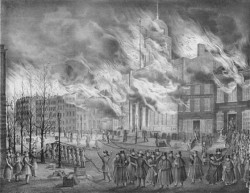 December 16, 1835 — Fire consumed nearly 700 buildings buildings in New York City today. It spread to 17 city blocks — but only killed two people. It cost an estimated $20 million in property damage.
December 16, 1835 — Fire consumed nearly 700 buildings buildings in New York City today. It spread to 17 city blocks — but only killed two people. It cost an estimated $20 million in property damage.
Spotted nearly 100 miles away in Philadelphia, the “Great Fire of New York,” began this evening in a five-story warehouse at 25 Merchant Street, now known as Beaver Street (at the intersection of Hanover Square and Wall Street).
Gale-force winds and below-freezing temperature made it nearly impossible to contain. Firefighters were forced to drill holes through ice in the river to access water, which later froze in the hoses and pipes. At about 2 a.m., Marines returned with gunpowder from the Brooklyn Navy Yard and began to blow up buildings in the fire’s path.
An investigation did not assess the blame and reported that the cause of the fire was a gas pipe that had burst and been ignited by a coal stove.
Sources: wikipedia, history1800s, “History of New York”, New-York Historical Society
Where did the first state road run?
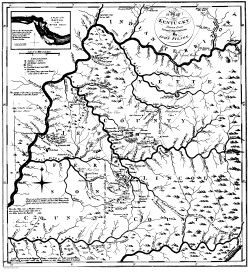 December 14, 1793 — The first state road is authorized today, running from Frankfort, KY to Cincinnati.
December 14, 1793 — The first state road is authorized today, running from Frankfort, KY to Cincinnati.
Russell Dyche, in “Laurel County Kentucky,” explains that the original settlers’ route to Kentucky was over the Wilderness Road in the Virginia and Tennessee mountains, part of it blazed by Daniel Boone.
By 1795, Kentucky had appropriated $2,000 to extend this road from Crab Orchard to Cumberland Gap. The Wilderness Road was not used for nearly a century but is now a part of U.S. Route 25.
The Wilderness Road offered something new. Emigrants could bring their wagons and more of their household goods when they moved from eastern states through Virginia to their new Kentucky home. The few people living along the route, and more especially the people in the settlements who were wanting more emigrants and travelers, were happy about it.
Who gave Beethoven his first lesson in music composition?
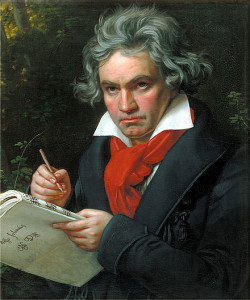 December 12, 1792 — In Vienna, Ludwig Von Beethoven (right, then 22) received his first lesson in music composition from Franz Joseph Haydn today.
December 12, 1792 — In Vienna, Ludwig Von Beethoven (right, then 22) received his first lesson in music composition from Franz Joseph Haydn today.
Historians believe that Beethoven was first introduced to Haydn in late 1790, when the latter was traveling to London and stopped in Bonn around Christmas time. A year and a half later, they met in Bonn on Haydn’s return trip from London to Vienna, and it is likely that arrangements were made at that time for Beethoven to study with the old master.
It was a tumultuous time. Rumors of war were spilling out of France, and soon after his arrival in Vienna, Beethoven learned that his father had died. Mozart had also recently died.
Beethoven responded to the widespread feeling that he was a successor to the recently deceased Mozart by studying that master’s work and writing works with a distinctly Mozartean flavor.
Who established New York’s first daily newspaper?
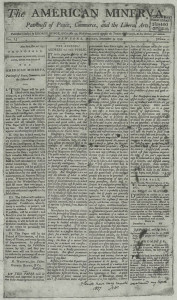 December 9, 1793 — Noah Webster established New York’s first daily newspaper, the American Minerva.
December 9, 1793 — Noah Webster established New York’s first daily newspaper, the American Minerva.
It aimed to contain “the earliest intelligence, collected from the most authentic sources,” and it’s full of those long s letterforms (ſ) that look like lowercase fs and were by then not long for this world.
Webster, a Federalist who wanted to discourage the French influence in the US, made his first “address to the public” that covered nearly the entire front page.
The American Minerva ran for 744 issues between 1793 and 1796. It was bought out and eventually became the New York Sun, which was published until 1950.
Who won the 2nd quadrennial presidential election?
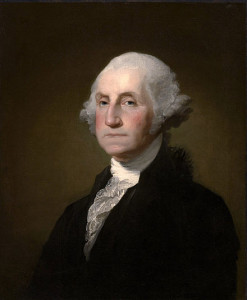 December 5, 1792 — George Washington is re-elected as the President of the United States today.
December 5, 1792 — George Washington is re-elected as the President of the United States today.
The election process lasted just more than a month — from Friday, November 2 to Wednesday, December 5, 1792. As in the first presidential election, Washington was considered to have run unopposed, but electoral rules of the time required each presidential elector to cast two votes without distinguishing which was for president and which for vice president.
The recipient of the most votes would then become president, and the runner-up vice president. Incumbent Vice President John Adams received 77 votes and was also re-elected (Washington received 132 votes, or one from each elector).
This election was the first in which each of the original 13 states appointed electors (in addition to newly added states of Kentucky and Vermont).
It was also the only presidential election that was not held exactly four years after the previous election, although part of the previous election was technically held four years prior. The second inauguration was on March 4, 1793 at the Senate Chamber Congress Hall in Philadelphia.
What did the Treaty of Paris accomplish?
 November 30, 1782 — The Treaty of Paris was signed today, officially ending the Revolutionary War between Great Britain and the United States.
November 30, 1782 — The Treaty of Paris was signed today, officially ending the Revolutionary War between Great Britain and the United States.
It recognized American independence and established borders for the new nation.
After the British defeat at Yorktown, peace talks in Paris began in April 1782 between Richard Oswarld representing Great Britain and the American Peace Commissioners Benjamin Franklin, John Jay, and John Adams.
The American negotiators were joined by Henry Laurens two days before the preliminary articles of peace were signed. However, it was not formally signed until September 3, 1783.
The Continental Congress, which was temporarily situated in Annapolis, Maryland, at the time, officially ratified the Treaty on January 14, 1784.
What is the Treaty of Hopewell?
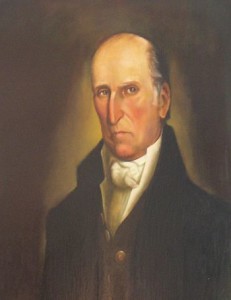 November 28, 1785 — The first Treaty of Hopewell was signed today between U.S. representatives Benjamin Hawkins, Andrew Pickens (pictured right), and Joseph Martin and members of the Cherokee People.
November 28, 1785 — The first Treaty of Hopewell was signed today between U.S. representatives Benjamin Hawkins, Andrew Pickens (pictured right), and Joseph Martin and members of the Cherokee People.
Signed at Hopewell Plantation, the treaty laid out a western boundary for American settlement. The treaty gave rise to the sardonic Cherokee phrase of Talking Leaves, since they claimed that when the treaties no longer suited the Americans, they would blow away like talking leaves.
Included in the signatures of the Cherokee delegation were several from leaders of the Chickamauga/Lower Cherokee, including two from the town of Chickamauga itself and one from Lookout Mountain Town.
The Cherokee complained at the treaty that some 3,000 white settlers of the de facto State of Franklin were already squatting on the Cherokee side of the agreed line, between the Holston and French Broad Rivers, and they continued to dispute that region until a new border was defined by the 1791 Treaty of Holston.
What was the impetus for the Seminole Wars?
 November 27, 1817 — US soldiers attack the Florida Indian village, beginning the Seminole Wars.
November 27, 1817 — US soldiers attack the Florida Indian village, beginning the Seminole Wars.
Also known as the Florida Wars, there were three conflicts in Florida between the US Army and the Seminoles — which was the collective name given to the amalgamation of various groups of native Americans and a smattering of others primarily African Americans who settled in Florida in the early 18th century.
Historians explain that the first of three Seminole Wars arose out of tensions relating to General Andrew Jackson’s excursions into northern Spanish Florida against the Seminoles beginning in 1816. The governments of Britain and Spain both expressed outrage over the “invasion” but ultimately, the Spanish Crown agreed to cede Florida to the United States in the Adams–Onís Treaty of 1819.
They were the largest conflicts in the United States between the War of 1812 and the American Civil War. Taken together, the Seminole Wars were the longest and most expensive (both in human and monetary terms) Indian Wars in United States history and one of the most expensive of all wars ever fought by the U.S. as a percentage of gross national product.
By 1858, most of the remaining Seminoles were weary of war and with their villages and farms mostly destroyed, agreed to be shipped to Oklahoma in exchange for promises of safe passage and cash payments to their chiefs. An estimated 100 Seminoles still refused to leave and moved deep into the Florida Everglades to live on land that was unwanted by white settlers.
What is “Evacuation Day?”
 November 25, 1783 — Today marks the day that British troops departed from New York Town on Manhattan Island at the end of the American Revolutionary War.
November 25, 1783 — Today marks the day that British troops departed from New York Town on Manhattan Island at the end of the American Revolutionary War.
Gen. George Washington triumphantly led the Continental Army from his former headquarters, north of the City, across the Harlem River south down Manhattan through The Battery at the foot of Broadway.
The last shot of the war was reportedly fired on this day — by a British gunner at jeering crowds gathered on Staten Island as his ship passed through New York Harbor. The shot fell well short of its target.
Which active stratovolcano erupted today in 1842?
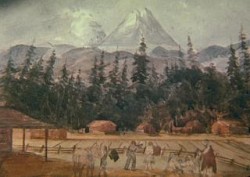 November 22, 1842 — Mount St Helens in Washington state erupted today. The active stratovolcano located in Skamania County, Washington, in the Pacific Northwest region of the United States, is 96 miles south of Seattle, Washington, and 50 miles northeast of Portland, Oregon.
November 22, 1842 — Mount St Helens in Washington state erupted today. The active stratovolcano located in Skamania County, Washington, in the Pacific Northwest region of the United States, is 96 miles south of Seattle, Washington, and 50 miles northeast of Portland, Oregon.
It takes its English name from the British diplomat Lord St Helens, a friend of explorer George Vancouver who made a survey of the area in the late 18th century.
As part of the Cascade Volcanic Arc, a segment of the Pacific Ring of Fire that includes over 160 active volcanoes, this volcano is well known for its ash explosions and pyroclastic flows.
And so it flowed today in 1842. It is part of a 57-year eruptive period that scientists believe began in 1800. Called the Goat Rocks period, this is the first time that both oral and written records exist.
While Mount St. Helens is most notorious for its catastrophic eruption on May 18, 1980 — when 52 people were killed, and 250 homes, 47 bridges, 15 miles of railways, and 185 miles of highway were destroyed — there were at least a dozen reported small eruptions of ash from 1831 to 1857.
In fact, Goat Rocks dome was the site of the bulge in the 1980 eruption, which also destroyed the entire north face and top 1,300 feet of the mountain.
Who succeeded William Wordsworth as the Poet Laureate?
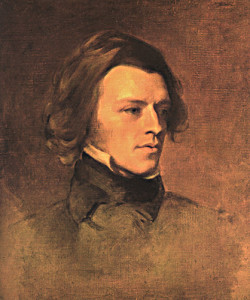 November 19, 1850 — Victorian poet Alfred Tennyson became the British Poet Laureate today, succeeding William Wordsworth. Elizabeth Barrett Browning and Leigh Hunt had also been considered.
November 19, 1850 — Victorian poet Alfred Tennyson became the British Poet Laureate today, succeeding William Wordsworth. Elizabeth Barrett Browning and Leigh Hunt had also been considered.
He held the position until his own death in 1892, the longest tenure of any laureate before or since.
Born on August 6, 1809, he was the fourth of 12 children, and at the age of 12 he wrote a 6,000-line epic poem. His father, the Reverend George Tennyson, tutored his sons in classical and modern languages, but also suffered frequent mental breakdowns that were exacerbated by alcoholism. One of Tennyson’s brothers had violent quarrels with his father, a second was later confined to an insane asylum, and another became an opium addict. Tennyson left home in 1827 to attend Trinity College, and the same year, he and his brother Charles published Poems by Two Brothers.
Tennyson is known to have excelled at penning short lyrics, such as “Break, Break, Break,” “Tears, Idle Tears,” and “Crossing the Bar.” Much of his verse was based on classical mythological themes, such as Ulysses. One of his best-known works, “The Charge of the Light Brigade,” is a dramatic tribute to the British cavalrymen involved in an ill-advised charge on October 25, 1854, during the Crimean War. Other esteemed works include “Ode on the Death of the Duke of Wellington,” and “Ode Sung at the Opening of the International Exhibition.”
Virginia Woolf wrote a satirical farce called Freshwater, showing several artists from the late Victorian era including Tennyson, Woolf’s great-aunt, the photographer Julia Margaret Cameron, painter George Frederic Watts and his young bride, the actress Ellen Terry.
Sources: wikipedia, npr.org, poets.org
Who was the first doctor to use chloroform as an anaesthetic?
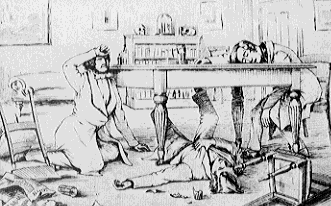 November 12, 1847 — Scottish obstetrician James Young Simpson is the first to use chloroform as an anesthetic today in 1847.
November 12, 1847 — Scottish obstetrician James Young Simpson is the first to use chloroform as an anesthetic today in 1847.
Yes, Sir Humphry Davy used the first anaesthetic in 1799 — nitrous oxide (aka: laughing gas). But Simpson discovered the properties of chloroform while sitting in his dining from with friends Drs Keith and Duncan. After inhaling the chemical they found that a general mood of cheer and humor set in, then suddenly all of them collapsed only to regain consciousness the next morning.
Simpson knew, as soon as he woke up, that he had found something that could be used as an anaesthetic. (more…)
What is the history of the Chrysanthemum?
 November 11, 1790 — Chrysanthemums are believed to have been introduced today in 1790 by the Chinese, who call it “Chu.” The Chinese city of Chu-Hsien (which means Chrysanthemum City) was named to honor the flower.
November 11, 1790 — Chrysanthemums are believed to have been introduced today in 1790 by the Chinese, who call it “Chu.” The Chinese city of Chu-Hsien (which means Chrysanthemum City) was named to honor the flower.
Described in writings as early as the 15th Century BC, its healing powers are well known. As an herb, it is believed to have the power of life, for its boiled roots have long been used as a headache remedy. Young sprouts and petals are yummy in salads, and its leaves have long been brewed for a festive drink.
Around the 8th century A.D., the chrysanthemum appeared in Japan, where the Imperial Order of the Chrysanthemum is the highest Order of Chivalry. Japan also has a National Chrysanthemum Day, which is called the Festival of Happiness.
In 1753, Swedish botanist Karl Linnaeus combined the Greek words chrysos, meaning gold with anthemon, meaning flower. Linnaeus was the founder of that branch of taxonomy dealing with plants and including the science of classification and identification. Experts say this is probably an accurate description of the ancient species, as it also points out the mum’s need for sunlight.
What disaster inspired the construction of the first modern lighthouse?
 November 10, 1847 — The passenger ship Stephen Whitney wrecked today in thick fog off the southern coast of Ireland, killing 92 of the 110 on board.
November 10, 1847 — The passenger ship Stephen Whitney wrecked today in thick fog off the southern coast of Ireland, killing 92 of the 110 on board.
The disaster resulted in the construction the Fastnet Rock lighthouse, which began in 1853 and produced a light on January 1, 1854. Designed by George Halpin, it stands 4.5 miles southwest of Cape Clear and southwest of Mizen Head.
Known as The Teardrop of Ireland (because it is the last sight of Ireland for emigrants sailing to America), it stands about around 91 feet tell and the cost was £17,390.
The original lighthouse had an oil burning lamp of 38 kilocandelas; in contrast modern lighthouses typically produce 1,300 kilocandelas. In 1883, an explosive fog signal was installed, which electrically detonated a small charge of guncotton every five minutes.
Happy National Sandwich Day: How did the sammie get its start?
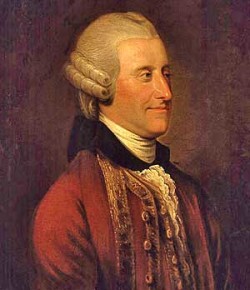 November 3, 1762 — Today is Sandwich Day in celebration of the day that British nobleman John Montagu, the 4th Earl of Sandwich, popularized the delicacy during the Revolutionary War. For years, early Americans considered eating a sandwich to be un-patriotic.
November 3, 1762 — Today is Sandwich Day in celebration of the day that British nobleman John Montagu, the 4th Earl of Sandwich, popularized the delicacy during the Revolutionary War. For years, early Americans considered eating a sandwich to be un-patriotic.
Here’s how the story goes: Food historians agree that Montagu had a substantial gambling problem, which led him to spend hours on end at the card table. During a particularly long binge, he asked the house cook to bring him something he could eat without getting up from his seat. His chef brought him the revolutionary sandwich, and a trend was born. Montagu enjoyed his meal so much that he ate it constantly, and as the creation grew popular in London society circles, and also took on the Earl’s name.
But whatscookingamerica.net says the first recorded sandwich was made by the rabbi, Hillel the Elder who lived during the 1st century B.C. He started the Passover custom of sandwiching a mixture of chopped nuts, apples, spices, and wine between two matzohs to eat with bitter herbs.
What’s the most popular sandwich in the States today? According to the menu research firm Datassential, Americans are most enchanted by the turkey sandwich (14%), followed by ham (11%), chicken (9%), and the sub (8%). Those classics — the PB&J and BLT — tied with grilled cheese (5%); roast beef came in at 4%. Additionally, data studied from 100,000 restaurant menus showed the most popular sandwich ingredients are: barbecue, chipotle, and pesto. Those gaining in popularity are: kimchee, aged cheddar, and naan.
Where is Mozart’s Symphony No. 36 first performed today in 1783?
November 4, 1783 — 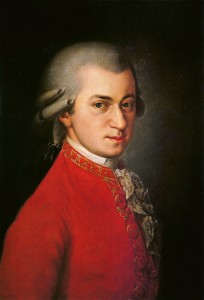 Wolfgang Amadeus Mozart’s Symphony No. 36 in C major, K. 425 premiered today in Linz, Austria. Known as the Linz Symphony, it was written by during a stopover in the Austrian town of Linz on his and his wife’s way back home to Vienna from Salzburg in late 1783.
Wolfgang Amadeus Mozart’s Symphony No. 36 in C major, K. 425 premiered today in Linz, Austria. Known as the Linz Symphony, it was written by during a stopover in the Austrian town of Linz on his and his wife’s way back home to Vienna from Salzburg in late 1783.
The entire symphony was written in four days to accommodate the local count’s announcement, upon hearing of the Mozarts’ arrival in Linz, of a concert. The première in Linz took place on 4 November 1783. The composition was also premièred in Vienna on 1 April 1784. The autograph score of the “Linz Symphony” was not preserved.
What is Londoner John Austin best known for?
 November 7, 1783 — Highwayman John Austin is the last man to be publicly hanged at London’s Tyburn gallows today. The hanging marked the end of Tyburn, a village then in the county of Middlesex, which was the site of executions for nearly 600 years.
November 7, 1783 — Highwayman John Austin is the last man to be publicly hanged at London’s Tyburn gallows today. The hanging marked the end of Tyburn, a village then in the county of Middlesex, which was the site of executions for nearly 600 years.
Austin was sentenced to death for the murder of labourer John Spicer from Kent. The Recorder of London, James Adair, described it as a “robbery with violence” that involved “cutting and wounding Spicer in a cruel manner.”
On the way to the gallows, Austin was accompanied by two guards and a chaplain. They stopped at two public houses, where drinks were served. Upon arrival at Tyburn, Austin’s cart was positioned under a beam and a noose attached around his head.
Unfortunately, the noose slipped up the back of his neck as the cart was taken from under him. The slackness in the rope prevented rapid asphyxiation, and it was said to have taken 10 minutes for him to choke to death.
The gallows were dismantled after the execution.
How much loot did Jesse James’ gang steal from a bank in Missouri today in 1866?
 October 30, 1866 — Jesse James and his gang robbed a bank in Lexington, Missouri today, stealing $2000.
October 30, 1866 — Jesse James and his gang robbed a bank in Lexington, Missouri today, stealing $2000.
The American outlaw, guerrilla, gang leader, bank robber, train robber, and murderer from the state of Missouri was the most famous member of the James-Younger Gang.
Jesse and his brother Frank (pictured right) were the most active with their gang from about 1866 until 1876, when their attempted robbery of a bank in Northfield, Minnesota resulted in the capture or deaths of several gang members. They continued in crime for several years, recruiting new members, but were under increasing pressure from law enforcement.
On April 3, 1882, James was killed by a member of his own gang, Robert Ford, who hoped to collect a reward on his boss’ head.
Which organization helped establish the International Committee of Red Cross?
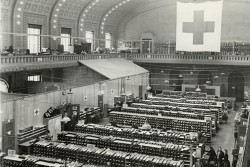 October 29, 1863 — Today, the International Committee of Red Cross formed as result of a conference held in Geneva, Switzerland. Its sole objective was to ensure protection and assistance for victims of armed conflict and strife through direct action around the world.
October 29, 1863 — Today, the International Committee of Red Cross formed as result of a conference held in Geneva, Switzerland. Its sole objective was to ensure protection and assistance for victims of armed conflict and strife through direct action around the world.
Meetings to found the organization — which is also known for encouraging the development of international humanitarian law, and promoting respect for it by governments and all weapon bearers — began in February 1863.
Among its five members was a local man named Henry Dunant who, the year before, had published a crusading book, “A Souvenir of Solferino,” which called for improved care for wounded soldiers in wartime. By the end of the year the committee had brought together government representatives to agree on Dunant’s proposal for national relief societies, to help military medical services.
In August 1864 it persuaded governments to adopt the first Geneva Convention. This treaty obliged armies to care for wounded soldiers, whatever side they were on, and introduced a unified emblem for the medical services: a red cross on a white background.
During the next 50 years, the ICRC expanded its work while national societies were established (the first in the German State of Württemberg in November 1863) and the Geneva Convention was adapted to include warfare at sea.
Why did New York gave up claim to Vermont today in 1790?
 October 28, 1790 — New York gave up claims to Vermont for $30,000 today. Negotiations for the sale began three years earlier, in 1787, when Alexander Hamilton, who was then a member of the New York Assembly. He introduced a bill that called for the recognition of the independence of Vermont.
October 28, 1790 — New York gave up claims to Vermont for $30,000 today. Negotiations for the sale began three years earlier, in 1787, when Alexander Hamilton, who was then a member of the New York Assembly. He introduced a bill that called for the recognition of the independence of Vermont.
Historians explain that at the time there was debate as to whether the capital of the new nation would be located in New York or Philadelphia. “Hamilton realized that if Vermont were admitted to the Union, her vote would be most important. He also realized it was important that a northern free state be admitted to offset two southern slave states, Kentucky and Tennessee, which would soon join the Union.”
New York and Vermont agreed to negotiate the differences between conflicting land claims. After negotiations, Vermont agreed to pay New York $30,000 compensation while New York gave up her Vermont land claims.
Vermont’s next step in the process of admission to the Union was to ratify the new United States Constitution. In January 1791, a convention authorized by the Vermont General Assembly met in Bennington to consider ratification. One of the delegates to the convention, Supreme Court Judge Nathaniel Chipman, said Vermont was too small in relation to a new powerful union to remain independent.
“Whenever our interests clash with those of the union, it requires very little political sagacity to foretell that every sacrifice must be made on our part… United we become great, from the reflected greatness of the empire with which we unite.”
The United States Constitution was ratified 105 to 4 by Vermont. The adoption was favorably received throughout the nation. In Albany, New York, the event was celebrated by a parade and a 14-gun salute.
By Act of Congress on March 4, 1791, Vermont was admitted to the Union as the 14th state, the first state to join the union. The Congressional Act declared “that on the 4th day of March 1791, the said State, by the name and style of the State of Vermont, shall be received into this Union as a new and entire member of the United States of America.”
Which branch of the armed forces was formed today?
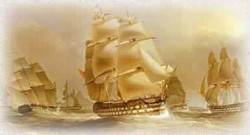 October 27, 1775 — The US Navy formed today. Rooted in the American seafaring tradition, it produced a large community of sailors, captains and shipbuilders in the colonial era.
October 27, 1775 — The US Navy formed today. Rooted in the American seafaring tradition, it produced a large community of sailors, captains and shipbuilders in the colonial era.
In the early stages of the American Revolutionary War, Massachusetts had its own navy. The establishment of a national navy was an issue of debate among the members of the Second Continental Congress.
Supporters argued that a navy would protect shipping, defend the coast, and make it easier to seek out support from foreign countries. Detractors countered that challenging the British Royal Navy, then the world’s preeminent naval power, was a foolish undertaking.
Commander in Chief George Washington resolved the debate when he commissioned seven ocean-going cruisers, starting with the schooner USS Hannah, to interdict British supply ships, and reported the captures to the Congress.
The Continental Navy achieved mixed results; it was successful in a number of engagements and raided many British merchant vessels, but it lost 24 of its vessels, and at one point was reduced to two in active service.
The Continental Navy was disbanded at war’s end, and the US was without a navy for nearly a decade—a state of affairs that exposed its merchant ships to a series of attacks by Barbary pirates. Congress passed the Naval Act of 1794 which established a permanent standing navy.
Which Ivy League University received its charter today in 1746?
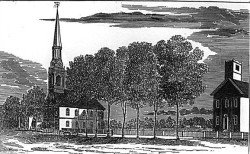 October 22, 1746 — Princeton University received its charter today. Called the College of New Jersey (which was its name for the next 150 years), it was British North America’s fourth college devoted to the education of young men. It became co-educational in 1969.
October 22, 1746 — Princeton University received its charter today. Called the College of New Jersey (which was its name for the next 150 years), it was British North America’s fourth college devoted to the education of young men. It became co-educational in 1969.
Two Princeton alumni have served as US presidents — James Madison (Class of 1771), and Woodrow Wilson, (Class of 1879).
Located in Elizabeth for one year and then in Newark for nine, the College of New Jersey moved to Princeton in 1756. For nearly half a century, the entire college was housed in Nassau Hall in Princeton — classrooms, dormitories, library, chapel, dining room and kitchen. Nassau Hall, named to honor King William III, Prince of Orange (of the House of Nassau), was one of the largest buildings in the American colonies.
During the American Revolution, it survived occupation by soldiers from both sides and today bears a cannonball scar from the Battle of Princeton (Jan. 3, 1777). In 1783 the Continental Congress met in Nassau Hall, thus making it the capitol of the United States for a short time.
As part of the sesquicentennial celebrations in 1896, the College of New Jersey changed its name to Princeton University and adopted as an informal motto “Princeton in the nation’s service,” the title of the keynote speech by Woodrow Wilson, then a faculty member. Six years later Wilson became Princeton’s 13th president. During his term of office (1902-10) plans for building the Graduate College were finalized, and what had been the College of New Jersey began to grow into a full-scale university.
When did the famous Can-Can dancers arrive in the US?
 October 21, 1830 — The famous dance, the Can-Can, is performed for the first time today in Paris. The high-energy and physically demanding music hall dance, was performed by a chorus line of female dancers who wore costumes with long skirts, petticoats, and black stockings.
October 21, 1830 — The famous dance, the Can-Can, is performed for the first time today in Paris. The high-energy and physically demanding music hall dance, was performed by a chorus line of female dancers who wore costumes with long skirts, petticoats, and black stockings.
The main features of the dance are the lifting and manipulation of the skirts, with high kicking and suggestive, provocative body movements. The Infernal Galop from Jacques Offenbach’s Orpheus in the Underworld is the tune most associated with the dance.
By the 1890’s individual the Can-Can was being performed in Britain, the US, and Canada. Its dancers became renowned, and were highly paid for their appearances.
In fact, the Oxford Companion to Music defined the Can-Can as “a boisterous and latterly indecorous dance of the quadrille order, exploited in Paris for the benefit of such British and American tourists as will pay well to be well shocked. Its exact nature is unknown to anyone connected with this Companion.”
Was the Can-Can ever danced without drawers? No. Well, not really.
Historians explain that this mistaken belief took root when the dance first appeared in working-class dance halls in the 1830s, and drawers were not a standard item of underwear. However, they were adopted in the 1850s because of the advent of the hooped skirt or crinoline. Initially drawers were of the “open” type, being essentially two tubes of material, one for each leg, and this is perhaps another reason for the myth. However, the Moulin Rouge management did not permit dancers to perform in such revealing garments.
Who is considered the first modern historian of ancient Rome?
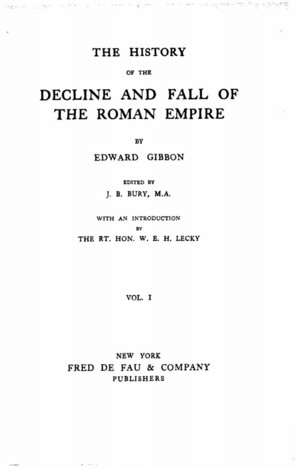 October 15, 1764 — Today, Edward Gibbon observed a group of friars singing in the ruined Temple of Jupiter in Rome, which inspired him to begin work on “The History of the Decline and Fall of the Roman Empire.”
October 15, 1764 — Today, Edward Gibbon observed a group of friars singing in the ruined Temple of Jupiter in Rome, which inspired him to begin work on “The History of the Decline and Fall of the Roman Empire.”
Here’s why: Gibbon saw the Praetorian Guard as the primary catalyst of the empire’s initial decay and eventual collapse. It was a seed planted by Augustus when the empire was established. His writings cited repeated examples of the guard abusing their power with calamitous results, including imperial assassination and demands for increased pay.
About the book: It traces the trajectory of Western civilization (as well as the Islamic and Mongolian conquests) from the height of the Roman Empire to the fall of Byzantium. It was published in six volumes. Volume I was published in 1776 and went through six printings. Volumes II and III were published in 1781; volumes IV, V, and VI in 1788–89.
The original volumes were published in quarto sections, a common publishing practice of the time. The work covers the history of the Roman Empire, Europe, and the Catholic Church from 98 to 1590 and discusses the decline of the Roman Empire in the East and West. Because of its relative objectivity and heavy use of primary sources, unusual at the time, its methodology became a model for later historians. This led to Gibbon being called the first modern historian of ancient Rome.
Who published the first edition of the “Old Farmer’s Almanac” today in 1792?
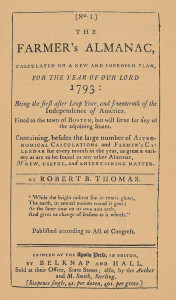 October 13, 1792 — The first edition of the “Old Farmer’s Almanac” is published today by editor Robert B. Thomas.
October 13, 1792 — The first edition of the “Old Farmer’s Almanac” is published today by editor Robert B. Thomas.
It was George Washington’s first term as president, and although many other almanacs were being published at the time, Thomas’s upstart almanac became an immediate success. In fact, by the second year, circulation had tripled from 3,000 to 9,000. Back then, the Almanac cost only six pence (about nine cents).
Records and predicting astronomical events (the rising and setting of the Sun, for instance), tides, weather, and other phenomena with respect to time — what made The Old Farmer’s Almanac different from the others was that Thomas’s astronomical and weather predictions were more accurate, the advice more useful, and the features more entertaining.
Based on his observations, Thomas used a complex series of natural cycles to devise a secret weather forecasting formula, which brought uncannily accurate results, traditionally said to be 80 percent accurate. (Even today, his formula is kept safely tucked away in a black tin box at the Almanac offices in Dublin, New Hampshire.)
Thomas’s last edition, in 1846, was not much different from his first, over 50 years earlier. However, in that time he established The Old Farmer’s Almanac as America’s leading periodical by outselling and outlasting the competition. He died in 1846 at the age of 80, supposedly reading page proofs for the 1847 edition.
What invention did Thomas Edison patent today in 1868?
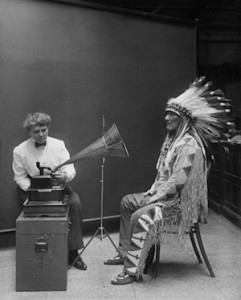 October 11, 1868 — Thomas Alva Edison patented his first invention today: the electric voice machine. This was the first of 1,093 patents that he was issued during his lifetime (February 11, 1847 – October 18, 1931).
October 11, 1868 — Thomas Alva Edison patented his first invention today: the electric voice machine. This was the first of 1,093 patents that he was issued during his lifetime (February 11, 1847 – October 18, 1931).
The American inventor and businessman developed many devices that greatly influenced life around the world, including the phonograph, the motion picture camera, and the long-lasting, practical electric light bulb.
Dubbed “The Wizard of Menlo Park,” he was one of the first inventors to apply the principles of mass production and large-scale teamwork to the process of invention, and because of that, he is often credited with the creation of the first industrial research laboratory.
Image: Frances Densmore recording Blackfoot chief Mountain Chief on a cylinder phonograph for the Bureau of American Ethnology (1916)




